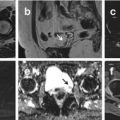and Jurgen J. Fütterer2, 3
(1)
Department of Radiological Sciences, Oncology and Pathology, Sapienza University of Rome, Rome, Italy
(2)
Department of Radiology and Nuclear Medicine, Radboudumc, Nijmegen, The Netherlands
(3)
MIRA Institute for Biomedical Technology and Technical Medicine, University of Twente, Enschede, The Netherlands
Xanthogranulomatous Pyelonephritis (XGN)
It is an uncommon condition characterized by chronic granulomatous process, induced by recurrent bacterial urinary tract infection, in which the renal parenchyma is ultimately replaced with lipid-laden (foamy) macrophages.
Most patients are middle-aged and diabetic female patients who present with symptoms like flank pain, hematuria, malaise, weight loss, and low-grade fever.
The preoperative diagnosis of XGN is difficult because of its nonspecific clinical presentation. Hematuria and hydronephrosis are sometimes encountered.
CT: Typical findings are the combination of a nonfunctioning unilateral enlarged kidney and parenchymal inflammation. A central calculus within a contracted renal pelvis, multiple areas of low attenuation representing expansion of the calyces filled with pus, and inflammatory changes in the perinephric fat are often present. The walls of the dilated calyces demonstrate enhancement due to the vascularity of the surrounding granulation tissue and compressed normal renal parenchyma.
Stay updated, free articles. Join our Telegram channel

Full access? Get Clinical Tree




